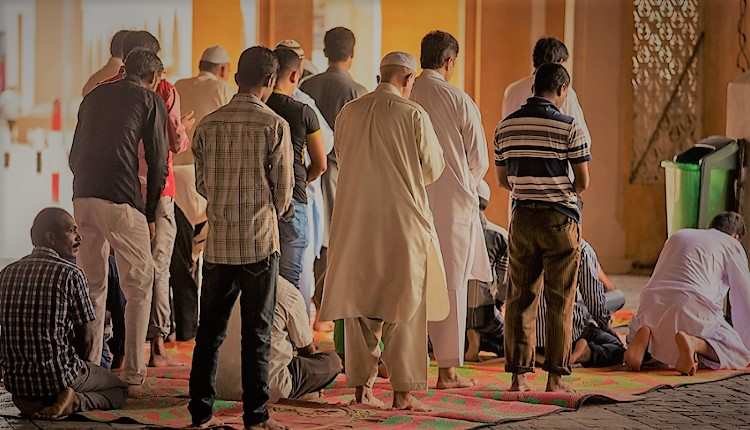Dressing up for prayers and covering ankles
I have had many debates with people regarding the raising of one’s pants/shalwar above the ankle specifically for the duration of Salaat. This act seems illogical and I have never heard any injunction in this regard, except a broad-sweeping one which need not apply necessarily to prayer:
…the part of cloth that is under the ankle will be burned in HellFire…
Could you please clarify whether:
1. Raising one’s garment above the ankle is a requirement for Salaat?
2. Whether the whole issue of keeping one’s garment is applicable to the prevalent lifestyle, especially since it is no longer considered ‘arrogant’ to do so?
Answer
There are two aspects of this Question:
1. What dress should one wear while saying one’s prayers; and
2. Is uncovering one’s ankles a part of the requirements Muslim men are expected to observe in their dress?
As for the question of the dress to be worn at the time of prayers, the Quran is requiring us do this:
“O sons of Adam, adorn yourself at every time of worship” (7:31)
What it essentially means is that one has got to be properly dressed in a manner one is dressed for important occasions, especially when it comes to the question of visiting the mosques. If uncovering one’s ankles is a part of the normal dress of an individual, then most certainly the same dress should be used for saying prayers, because one has to use one’s normal, decent dress for the purpose of praying and not any special one that is distinct from the usual dress.
What kind of dress should a male Muslim wear? A clear answer to this question was given by the prophet, may Allah’s mercy be on him:
“Eat whatever you wish and wear whatever you desire, so long as two conditions are not violated: There should neither be extravagance in it nor arrogance.” (Bukhari, narrated by Ibn Abbas)
Obviously, one has to consider it to be implied in this statement that the food and dress one is consuming and wearing shouldn’t be otherwise prohibited from the point of view of the Shariah.
Unfortunately, those who have an atomistic approach towards learning Islam, jump to hasty, emotional conclusions by considering only one aspect of the issue at hand. In my opinion, the only correct approach towards understanding Islamic teachings is to look at all aspects of the issue to draw final conclusions. You will see a good example of what I am trying to say in the following description on the question of uncovering ankles.
Those Muslims who believe that uncovering ankles is a necessary part of a male Muslim’s dress rely on the following hadith of Sahih Bukhari:
“The part of dress that falls below ankles shall be in the hell-fire”.
This hadith doesn’t mention any reasons for this warning. Many good Muslims believe that we are not in the business of knowing what are the reasons behind a particular injunction. All that we are expected to do is to know what the injunction requires us to do and to follow it properly. The idea is indeed commendable, but an important point that is missed in this understanding is that in a hadith sometimes a narrator can miss an important part of the original statement of the prophet, sallallahu alaihi wasallam, or doesn’t describe the proper context of it and therefore it is imperative in order to do justice with the cause of understanding Islam to look at all aspects of the statement from whatever sources one can. In this particular case, for instance, the immediately following hadith of Bukhari reads like this:
“The one who while walking drags his garment on the ground arrogantly, God Almighty would not even look at him on the day of judgement.”
This hadith is, in my opinion, clarifying the rationale behind the injunction that was mentioned in the previous one and is also consistent with spirit of the hadith mentioned earlier.
The above understanding is further clarified by another hadith reported in Sahih Bukhari. We are informed that the prophet said,
“Allah will not look, on the Day of Resurrection, at the person who drags his garment (behind him) out of arrogance.”
On that Abu Bakr said,
“O Allah’s Apostle! One side of my Izar (garment) hangs low if I do not take care of it.”
The Prophet said,
“You are not one of those who do that out of arrogance.”
On the basis of these facts therefore, I agree with the opinion of those scholars who believe that it was a part of the dress of the rich, arrogant people of the prophet’s time that they used to not only cover their ankles with their garments but would also allow them to drag on the ground. The prophet, may Allah’s mercy be on him, stopped Muslims to emulate them primarily to stay away from all traces of arrogance.
Feedback by Mr. Wasif M. Khan:
Dresses that dragged on the ground were generally worn by the pagan and so-called Christian royalty, a fact that is in much evidence in every historical movie e.g. Cleopatra, etc. etc. Even today, Western brides may wear such tails generally carried by bridesmaids.

